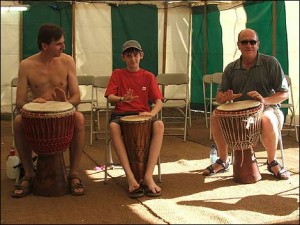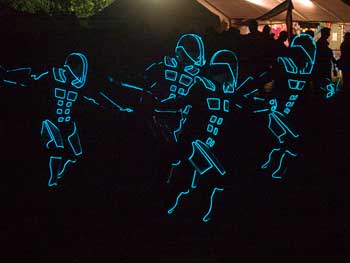 This year our summer tour took in Beautiful Days for the first time. This festival has been widely described as “like festivals used to be”. I think that phrase is meant to distinguish Beautiful Days from the sort of festival that’s sponsored by makers of lager and mobile ‘phone networks, but it must have been created by a twenty-something marketing director. I remember how festivals used to be, and they weren’t like this.
This year our summer tour took in Beautiful Days for the first time. This festival has been widely described as “like festivals used to be”. I think that phrase is meant to distinguish Beautiful Days from the sort of festival that’s sponsored by makers of lager and mobile ‘phone networks, but it must have been created by a twenty-something marketing director. I remember how festivals used to be, and they weren’t like this.
If you’ve ever seen the film of Woodstock, the archetype for later festivals, you’ll remember no food, no toilets, no information, a sea of mud, bands turning up a day late or not at all, playing on a single stage with terrible PA, interminable waits between acts, and some nasty thuggery. Contrast this with Beautiful Days:
- delicious food
In the festivals of my youth, you could either stand in an endless queue to be fleeced by the chicken ‘n’ chips vendor or the same for the hot dog vendor. At Beautiful Days there was a choice of tasty wholesome meals from some of the best festival caterers.
- ample clean toilets
The Beatiful Days toilet fairies were constantly doing the rounds, keeping the facilities clean, fresh and well-stocked with paper.
- child-friendly
At the festivals of old there were no children. Beautiful Days had a happy and mostly-free area dedicated to making sure the children had a good time too.
- more music
As a paid-up old fogey, I couldn’t allow that the music now is better. But there is just so much more of it. Beautiful Days offered two main stages and a dance tent, all of which ran more or less to time, and the turnarounds between the acts were effectively managed. And we did see some great performances, my highlights being Bellowhead, the Eliza Carthy Band, Billy Bragg with the acoustic Blokes (thanks for Levi Stubbs’ Tears), and my first experience of Jill Sobule.The nightly showing of Freeborn John, which allowed members of The Levellers to dress up as cavaliers, and involved the English Civil War Society in the gratuitous firing of muskets, was a “concept”, and thus unquestionably ’70s. And what a glorious show it was, too. Apparently a recording is promised. More throwbacks like this, please.
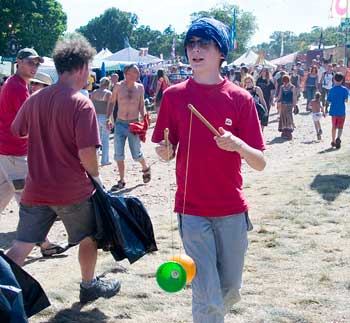 But yes, there were some reminders of how festivals used to be:
But yes, there were some reminders of how festivals used to be:
- traffic jams
Although Glastonbury now knows how to get 120,000 people onto the site in the manner of a military landing, a mere 10,000 of us spent two hours stationary in a traffic queue waiting to reach the Beautiful Days gate. Very nostalgic.
- security thugs
We’d already half-erected our tent when a short bald muscly man in uniform with walkie-talkie zoomed up self-importantly on a quad-bike and told us in the choicest language to move on, because our chosen spot was reserved for the security team. Not a very nice man, but I suspect he might have been worse if I hadn’t managed to suppress the urge to giggle at his pompousness.
The rest of our Beautiful Days photos are here.
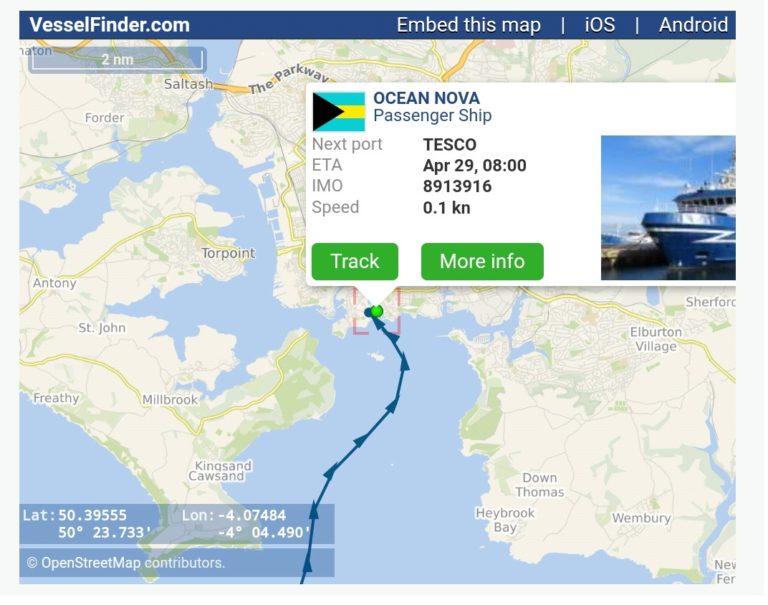

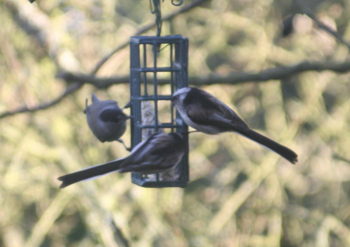 For the last few days we’ve had a blackcap visiting our garden. Here it is sharing the feeder with a couple from our troupe of long-tailed tits.
For the last few days we’ve had a blackcap visiting our garden. Here it is sharing the feeder with a couple from our troupe of long-tailed tits.



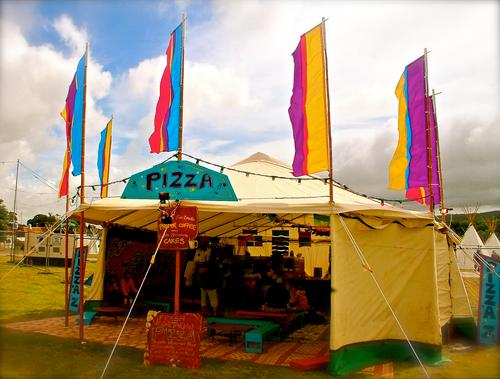 Just as you thought festival pizza was always going to be unpleasant greasy stuff best ignored, along comes the Pizza Tabun. Not a stall to visit in a hurry, because each pizza is rolled from fresh dough, topped to your specification and cooked to order in their special pizza oven. But the tent is a charming place to wait, with its comfy cushions and low tables. Unlike the previous entries, this one is also loved by the junior festival-goers, both for the pizza and the chocolate brownies. And the proprietor is a lovely man, whose manners belie his Steven Berkoff lookalike appearance.
Just as you thought festival pizza was always going to be unpleasant greasy stuff best ignored, along comes the Pizza Tabun. Not a stall to visit in a hurry, because each pizza is rolled from fresh dough, topped to your specification and cooked to order in their special pizza oven. But the tent is a charming place to wait, with its comfy cushions and low tables. Unlike the previous entries, this one is also loved by the junior festival-goers, both for the pizza and the chocolate brownies. And the proprietor is a lovely man, whose manners belie his Steven Berkoff lookalike appearance.

 Yesterday we watched a squirrel move home with her three babies. Sharing our garden with two cats had proved too much for her. One by one she carried her babies, tiny mouse-sized creatures with thin tails, in her mouth to their new nest, racing as fast as she could. You may just be able to make one out in the blurry photo on the right. Job done, she returned for a tasty rosehip.
Yesterday we watched a squirrel move home with her three babies. Sharing our garden with two cats had proved too much for her. One by one she carried her babies, tiny mouse-sized creatures with thin tails, in her mouth to their new nest, racing as fast as she could. You may just be able to make one out in the blurry photo on the right. Job done, she returned for a tasty rosehip.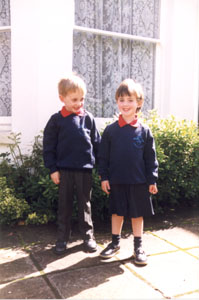
 On your left, Tom and Clara starting school in September 1998, in their shiny new shoes and too-big uniforms. And on the right, the same scene in September 2005. Spot the differences.
On your left, Tom and Clara starting school in September 1998, in their shiny new shoes and too-big uniforms. And on the right, the same scene in September 2005. Spot the differences.